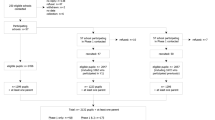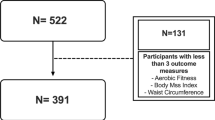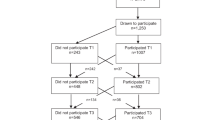Abstract
Background/objectives
Early childhood is characterised by rapid development and is a critical period for the establishment of activity behaviours. We aim to examine how physical activity (PA) and sedentary behaviour (SB) track during the first 5 years of life, and to investigate associations between trajectories and body composition at 5 years of age.
Subjects/methods
A total of 438 participants (50% male) wore an Actical accelerometer for 5 days at at least two of 1, 2, 3.5 and 5 years of age. Spearman correlation coefficients examined PA tracking from age 1 to 5 and trajectories of PA and SB were estimated using discrete mixture modelling. Regression models tested associations between both PA and SB trajectories and body composition measures.
Results
Tracking coefficients for PA ranged from r = 0.31–0.51 across the ages, with similar tracking observed for sedentary behaviour (r = 0.21–0.39). Four distinct trajectory patterns were identified separately for PA and SB: consistently low, consistently high, increasing and decreasing. BMI and waist circumference were not significantly associated with PA trajectories, but those in the consistently high activity group had significantly lower % body fat (95% CI) at age 5 (14.3%; 13.5, 15.2) than those in the consistently low (16.8%; 15.6, 18.2) or increasing (15.7%; 14.7, 16.7) groups (P = 0.017). Sedentary behaviour trajectories were not associated with any of the anthropometric measures at age 5 (P > 0.05).
Conclusions
Physical activity and sedentary behaviour tracking is broadly similar from infancy to early childhood. Children with consistently higher levels of physical activity have reduced body fat at 5 years of age, although differences are relatively small.
This is a preview of subscription content, access via your institution
Access options
Subscribe to this journal
Receive 12 print issues and online access
$259.00 per year
only $21.58 per issue
Buy this article
- Purchase on Springer Link
- Instant access to full article PDF
Prices may be subject to local taxes which are calculated during checkout
Similar content being viewed by others
References
World Health Organization. Fact Sheet: Obesity and overweight. In: WHO Media Centre, 2016. http://www.who.int/mediacentre/factsheets/fs311/en/
Janssen I, LeBlanc AG. Systematic review of the health benefits of physical activity and fitness in school-aged children and youth. Int J Behav Nutr Phys Act. 2010;7:40.
Timmons BW, Naylor P-J, Pfeiffer KA. Physical activity for preschool children—how much and how? Appl Physiol Nutr Metab. 2007;32(S2E):S122–S134.
Campbell KJ, Lioret S, McNaughton SA, Crawford DA, Salmon J, Ball K, et al. A parent-focused intervention to reduce infant obesity risk behaviors: a randomized trial. Pediatrics. 2013;131:652–60.
Hnatiuk J, Ridgers ND, Salmon J, Campbell K, McCallum Z, Hesketh K. Physical activity levels and patterns of 19-month-old children. Med Sci Sports Exerc. 2012;44:1715–20.
Wijtzes AI, Kooijman MN, Kiefte-de Jong JC, de Vries SI, Henrichs J, Jansen W, et al. Correlates of physical activity in 2-year-old toddlers: the generation R study. J Pediatr. 2013;163:791–9.
Hinkley T, Crawford D, Salmon J, Okely AD, Hesketh K. Preschool children and physical activity: a review of correlates. Am J Prev Med. 2008;34:435–41.
Oliver M, Schofield GM, Kolt GS. Physical activity in preschoolers. Sports Med. 2007;37:1045–70.
Pate RR, Pfeiffer KA, Trost SG, Ziegler P, Dowda M. Physical activity among children attending preschools. Pediatrics. 2004;114:1258–63.
Timmons BW, LeBlanc AG, Carson V, Connor Gorber S, Dillman C, Janssen I, et al. Systematic review of physical activity and health in the early years (aged 0–4 years). Appl Physiol Nutr Metab. 2012;37:773–92.
Tucker P. The physical activity levels of preschool-aged children:a systematic review. Early Child Res Q. 2008;23:547–58.
Masse L, Fuemmeler B, Anderson C, Matthews C, Trost S, Catellier D, et al. Accelerometer data reduction: a comparison of four reduction algorithms on select outcome variables. Med Sci Sports Exerc. 2005;37(11 Suppl):S544–S554.
Malina RM. Tracking of physical activity and physical fitness across the lifespan. Res Q Exerc Sport. 1996;67(sup3):S-48–S-57.
Gabel L, Obeid J, Nguyen T, Proudfoot NA, Timmons BW. Short-term muscle power and speed in preschoolers exhibit stronger tracking than physical activity. Appl Physiol Nutr Metab. 2011;36:939–45.
Kelly LA, Reilly JJ, Jackson DM, Montgomery C, Grant S, Paton JY. Tracking physical activity and sedentary behavior in young children. Pediatr Exerc Sci. 2007;19:51–60.
Taylor RW, Murdoch L, Carter P, Gerrard DF, Williams SM, Taylor BJ. Longitudinal study of physical activity and inactivity in preschoolers: the FLAME study. Med Sci Sports Exerc. 2009;41:96–102.
Jackson DM, Reilly JJ, Kelly LA, Montgomery C, Grant S, Paton JY. Objectively measured physical activity in a representative sample of 3‐to 4‐year‐old children. Obesity. 2003;11:420–5.
Jones RA, Hinkley T, Okely AD, Salmon J. Tracking physical activity and sedentary behavior in childhood: a systematic review. Am J Prev Med. 2013;44:651–8.
Jiménez-Pavón D, Kelly J, Reilly JJ. Associations between objectively measured habitual physical activity and adiposity in children and adolescents: systematic review. Int J Pediatr Obes. 2010;5:3–18.
Belsky J. Experiencing the lifespan, 4th ed New York: Worth Publishers; 2009.
Moir C, Meredith-Jones K, Taylor BJ, Gray A, Heath A-L, Dale K, et al. Early intervention to encourage physical activity in infants and their families: an RCT. Med Sci Sports Exerc. 2016;48:2446–53.
Taylor RW, Heath A-LM, Galland BC, Cameron SL, Lawrence JA, Gray AR, et al. Three-year follow-up of a randomised controlled trial to reduce excessive weight gain in the first two years of life: protocol for the POI follow-up study. BMC Public Health. 2016;16:771. In press
Taylor BJ, Heath A-L, Galland BC, Gray AR, Lawrence JA, Sayers RM, et al. Prevention of overweight in infancy (POI.nz) study: a randomised controlled trial of sleep, food and activity interventions for preventing overweight from birth. BMC Public Health. 2011;11:942.
Taylor BJ, Gray AR, Galland BC, Heath A-L, Lawrence JA, Sayers RM, et al. Targeting sleep, food, and activity in infants for obesity prevention: an RCT. Pediatrics. 2017;139:e20162037.
Fangupo LJ, Heath A-L, Williams SM, Somerville MR, Lawrence JA, Gray AR, et al. Impact of an early-life intervention on the nutrition behaviors of 2-year old children: a randomized controlled trial. Am J Clin Nutr. 2015;102:704–12.
Cameron SL, Heath A-LM, Gray AR, Churcher B, Davies RS, Newlands A, et al. Lactation consultant support from late pregnancy with an educational intervention at 4 months of age delays the introduction of complementary foods in a randomized controlled trial. J Nutr. 2015;145:1481–90.
de Onis M, Onyango AW, Van den Broeck J, Chumlea WC, Martorell R. Measurement and standardization protocols for anthropometry used in the construction of a new international growth reference. Food Nutr Bull. 2004;25(1 Suppl):S27–36.
Onis M. Relationship between physical growth and motor development in the WHO child growth standards. Acta Paediatr. 2006;95(S450):96–101.
World Health Organization. WHO child growth standards based on length/height, weight and age. Acta Paediatr Suppl. 2006;450:76–85.
Squires, J., & Bricker, D. (2009). Ages & stages questionnaires, (ASQ-3). A parent-completed child monitoring system. 3rd ed. baltimore: MD: Brookes.
Goulding A, Taylor RW, Jones IE, Lewis-Barned NJ, Williams SM. Body composition of 4- and 5-year-old New Zealand girls: a DXA study of initial adiposity and subsequent 4-year fat change. Int J Obes & Relat Metab Disord. 2003;27:410–5.
Pfeiffer KA, McIver KL, Dowda M, Almeida MJ, Pate RR. Validation and calibration of the Actical accelerometer in preschool children. Med Sci Sports Exerc. 2006;38:152–7.
Rich C, Geraci M, Griffiths L, Sera F, Dezateux C, Cortina-Borja M. Quality control methods in accelerometer data processing: defining minimum wear time. PLoS ONE. 2013;8:e67206.
Meredith-Jones K, Williams SM, Galland BC, Kennedy G, Taylor RW. 24 h accelerometry: Impact of sleep-screening methods on estimates of physical activity and sedentary time. J Sport Sci. 2016;34:679–85.
Esliger DW, Copeland JL, Barnes JD, Tremblay MS. Standardizing and optimizing the use of accelerometer data for free-living physical activity monitoring. J Phys Act Health. 2005;2:366–83.
Adolph AL, Puyau MR, Vohra FA, Nicklas TA, Zakeri IF, Butte NF. Validation of uniaxial and triaxial accelerometers for the assessment of physical activity in children. J Phys Act Health. 2012;9:944–53.
Janssen X, Cliff D, Reilly J, Hinkley T, Jones R, Batterham M, et al. Evaluation of Actical equations and thresholds to predict physical activity intensity in young children. J Sports Sci. 2015;33:498–506.
Jones BL, Nagin DS. A note on a stata plugin for estimating group-based trajectory models. Sociol Methods Res. 2013;42:608–13.
Edwards NM, Khoury PR, Kalkwarf HJ, Woo JG, Claytor RP, Daniels SR. Tracking of accelerometer-measured physical activity in early childhood. Pediatr Exerc Sci. 2013;25:487–501.
Bornstein DB, Beets MW, Byun W, McIver K. Accelerometer-derived physical activity levels of preschoolers: a meta-analysis. J Sci Med Sport. 2011;14:504–11.
De Craemer M, De Decker E, De Bourdeaudhuij I, Vereecken C, Deforche B, Manios Y, et al. Correlates of energy balance‐related behaviours in preschool children: a systematic review. Obes Rev. 2012;13(s1):13–28.
Janz KF, Burns TL, Levy SM. Tracking of activity and sedentary behaviors in childhood—The Iowa Bone Development Study. Am J Prev Med. 2005;29:171–8.
Taylor RW, Williams SM, Farmer VL, Taylor BJ. Changes in physical activity over time in young children: a longitudinal study using accelerometers. PLoS ONE. 2013;8:e81567.
Vale S, Silva P, Santos R, Soares-Miranda L, Mota J. Compliance with physical activity guidelines in preschool children. J Sports Sci. 2010;28:603–8.
McKee DP, Murtagh EM, Boreham C, Nevill AM, Murphy MH. Seasonal and annual variation in young children’s physical activity. Med Sci Sports Exerc. 2012;44:1318–24.
Pate RR, Baranowski T, Dowda M, Trost SG. Tracking of physical activity in young children. Med Sci Sports Exerc. 1996;28:92–96.
Williams HG, Pfeiffer KA, O’Neill JR, Dowda M, McIver KL, Brown WH, et al. Motor skill performance and physical activity in preschool children. Obes (Silver Spring). 2008;16:1421–6.
Hager ER, Gormley CE, Latta LW, Treuth MS, Caulfield LE, Black MM. Toddler physical activity study: laboratory and community studies to evaluate accelerometer validity and correlates. BMC Public Health. 2016;16:936.
Gardner DS, Hosking J, Metcalf BS, Jeffery AN, Voss LD, Wilkin TJ. Contribution of early weight gain to childhood overweight and metabolic health: a longitudinal study (EarlyBird 36). Pediatrics. 2009;123:e67–73.
Nader PR, O’Brien M, Houts R, Bradley R, Belsky J, Crosnoe R, et al. Identifying risk for obesity in early childhood. Pediatrics. 2006;118:e594–601.
Acknowledgements
Funding
Funding was provided from the Health Research Council of New Zealand.
Author information
Authors and Affiliations
Corresponding author
Ethics declarations
Conflict of interest
The authors declare that they have no conflict of interest.
Electronic supplementary material
Rights and permissions
About this article
Cite this article
Meredith-Jones, K., Haszard, J., Moir, C. et al. Physical activity and inactivity trajectories associated with body composition in pre-schoolers. Int J Obes 42, 1621–1630 (2018). https://doi.org/10.1038/s41366-018-0058-5
Received:
Revised:
Accepted:
Published:
Issue Date:
DOI: https://doi.org/10.1038/s41366-018-0058-5
This article is cited by
-
Trajectories of physical activity and sedentary time in Norwegian children aged 3–9 years: a 5-year longitudinal study
International Journal of Behavioral Nutrition and Physical Activity (2022)
-
Outdoor time, screen time and sleep reported across early childhood: concurrent trajectories and maternal predictors
International Journal of Behavioral Nutrition and Physical Activity (2022)
-
Adherence to 24-h movement behavior guidelines and psychosocial functioning in young children: a longitudinal analysis
International Journal of Behavioral Nutrition and Physical Activity (2021)
-
A prediction model for childhood obesity in New Zealand
Scientific Reports (2021)
-
Joint physical-activity/screen-time trajectories during early childhood: socio-demographic predictors and consequences on health-related quality-of-life and socio-emotional outcomes
International Journal of Behavioral Nutrition and Physical Activity (2019)



